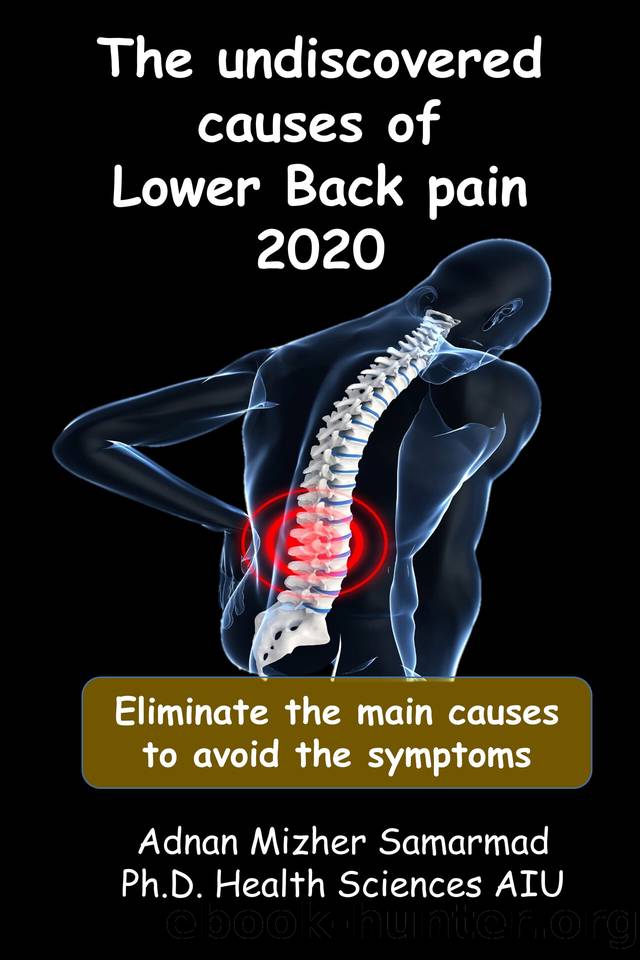The undiscovered causes of Lower Back Pain 2020: Eliminate the main causes to avoid the symptoms by Samarmad Adnan Mizher

Author:Samarmad, Adnan Mizher [Samarmad, Adnan Mizher]
Language: eng
Format: epub
Published: 2020-08-15T16:00:00+00:00
Figure 12: 12.1. Prior to treatment with 1st –LBE: left convex scoliosis of 23°, causing spinal disorder. 12.2. After 18 therapy sessions with 1st –LBE: scoliosis was corrected and reduced to 8°, and the LBP disappeared
Figure 13: 13.1. Prior to treatment with 1st –LBE: left convex scoliosis of 19°, causing spinal disorder. 13.2. After 18 therapy sessions with 1st –LBE: the scoliosis was corrected to minimum. Therefore, the LBP disappeared
5.4.4. Treating LBP
How do we treat pain and find difference between the types of muscle fibers?
By regulating the muscle geometry. The function of every muscle fiber in a muscle is governed by this regulation. Both tension and strength are controlled, and the tensions of individual muscle fibers are coordinated with one another.
When the tension in a single muscle fiber is too high, the movement is disturbed, and pain occurs. As a result, other organs, including the lungs and heart are affected and also suffer. (These rules do not apply to exertion pain).
My controlled exertion therapy normalizes and harmonizes the tension in the muscle fibers independently of the patient's strength level through specific tension and relaxation.
The 1st–LBE apparatus defines which strength (exertion) level that should be selected. The muscles become stronger and the spine is re-stabilized. The goals of the therapy are two-fold: 1) the patient’s average exertion level is defined; and 2) the patient’s maximum level of exertion of his/her spine, without damaging the spine, is defined.
Exertion pain affects 10% of back patients, involving mostly fast-twitch fibers. This reflects a physiological pain reaction, occurring through muscle contractions and is, independent of the exertion level (anaerobic), and immediately disappears when the muscles stop contracting.
However, if the patient does not understand this normal physiological response this can lead to a pathological change. Consequently, the patient becomes very cautious, causing muscle weakness that can lead to other ailments, such as lumbar spine syndrome. Exertion pain involving only fast-twitch fibers that can be diagnosed and treated successfully with the 1st–LBE apparatus (Fig. 14).
Download
This site does not store any files on its server. We only index and link to content provided by other sites. Please contact the content providers to delete copyright contents if any and email us, we'll remove relevant links or contents immediately.
Tools of Titans by Timothy Ferriss(7811)
Bodyweight Strength Training by Jay Cardiello(7672)
Born to Run: by Christopher McDougall(6893)
Inner Engineering: A Yogi's Guide to Joy by Sadhguru(6440)
Asking the Right Questions: A Guide to Critical Thinking by M. Neil Browne & Stuart M. Keeley(5355)
The Fat Loss Plan by Joe Wicks(4619)
Bodyweight Strength Training Anatomy by Bret Contreras(4464)
Yoga Anatomy by Kaminoff Leslie(4100)
Science and Development of Muscle Hypertrophy by Brad Schoenfeld(3969)
Dynamic Alignment Through Imagery by Eric Franklin(3919)
ACSM's Complete Guide to Fitness & Health by ACSM(3823)
The Four-Pack Revolution by Chael Sonnen & Ryan Parsons(3791)
Exercise Technique Manual for Resistance Training by National Strength & Conditioning Association(3785)
Bodyweight Strength Training: 12 Weeks to Build Muscle and Burn Fat by Jay Cardiello(3778)
Yoga Anatomy by Leslie Kaminoff & Amy Matthews(3737)
The Ultimate Bodybuilding Cookbook by Kendall Lou Schmidt(3706)
Yoga Therapy by Mark Stephens(3569)
Nutrition for Sport, Exercise, and Health by Spano Marie & Kruskall Laura & Thomas D. Travis(3556)
Nutrition for Sport, Exercise, and Health by Marie Spano & Laura Kruskall & D. Travis Thomas(3546)
